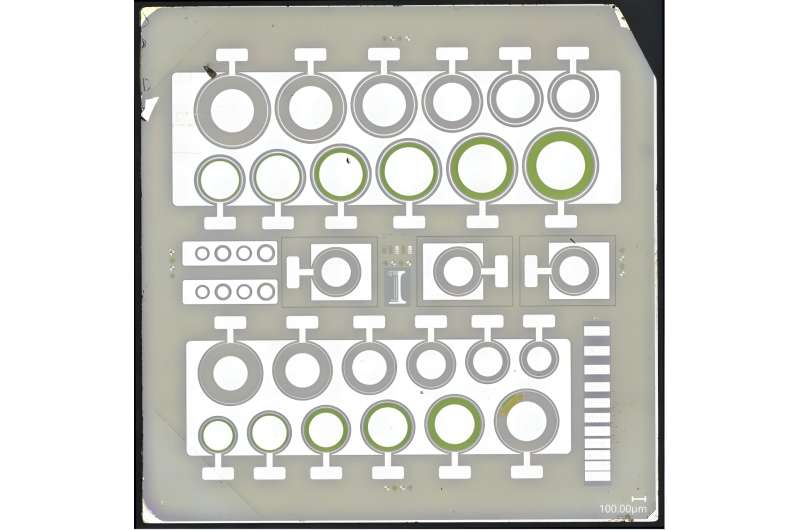This article has been reviewed according to Science X's editorial process and policies. Editors have highlighted the following attributes while ensuring the content's credibility:
fact-checked
trusted source
proofread
Next generation semiconductors: Diamond device shows highest breakdown voltage

To reach the world's goal of carbon neutrality by 2050, there must be a fundamental change in electronic materials to create a more reliable and resilient electricity grid. A diamond might be a girl's best friend, but it might also be the solution needed to sustain the electrification of society needed to reach carbon neutrality in the next 30 years.
Researchers at the University of Illinois Urbana-Champaign have developed a semiconductor device, made using diamond, that has the highest breakdown voltage and lowest leakage current compared to previously reported diamond devices. Such a device will enable more efficient technologies needed as the world transitions to renewable energies.
It is estimated that currently, 50% of the world's electricity is controlled by power devices, and in less than a decade, it is expected that that number will increase to 80%, while simultaneously, the demand for electricity will increase by 50% by 2050.
According to a new report from the National Academies of Sciences, Engineering, and Medicine, "Perhaps the single greatest technological danger to a successful energy transition is the risk that the nation fails to site, modernize, and build out the electrical grid. Without increased transmission capacity, renewables deployment would be delayed, and the net result could be at least a temporary increase in fossil fuel emissions, preventing the nation from achieving its emission reduction goals."
"To meet those electricity demands and modernize the electrical grid, it's very important that we move away from conventional materials, like silicon, to the new materials that we are seeing being adopted today like silicon carbide and the next generation of semiconductors—ultra-wide bandgap materials—such as aluminum nitride, diamond and related compounds," says electrical and computer engineering professor Can Bayram, who led this research, along with graduate student Zhuoran Han. The results of this work were published in the journal IEEE Electron Device Letters.
Most semiconductors are built using silicon and thus far, have met society's electrical needs. But as Bayram points out, "We want to make sure that we have enough resources for everyone, while our needs are evolving. Right now, we are using more and more bandwidth, we are creating more data (that also comes with more storage), and we are using more power, more electricity and more energy in general. The question is: is there a way we can make all of this more efficient, rather than generating more energy and building more power plants?"
Why diamond?
Diamond is an ultra-wide gap semiconductor with the highest thermal conductivity, which is the ability of a material to transfer heat. Due to these properties, diamond semiconductor devices can operate at much higher voltages and currents (with less material) and will still dissipate the heat without causing a reduction in electrical performance, compared to traditional semiconductor materials like silicon.
"To have an electricity grid where you need high current and high voltage, which makes everything more efficient for applications such as solar panels and wind turbines, then we need a technology that has no thermal limit. That's where diamond comes in," Bayram says.
Although many people associate diamond with expensive jewelry, diamond can be made more affordably and sustainably in the lab, making it a viable and important semiconductor alternative. Natural diamond is formed deep below Earth's surface under immense pressure and heat, but since it is essentially just carbon—of which there is an abundance of—artificially synthesized diamond can be made in weeks rather than billions of years, while also producing 100 times less carbon emissions.
In this work, Bayram and Han show that their diamond device can sustain high voltage, approximately 5 kV, although the voltage was limited by setup of measurement and not from the device itself. In theory, the device can sustain up to 9 kV. This is the highest voltage reported for a diamond device. Besides the highest breakdown voltage, the device also demonstrates the lowest leakage current, which can be thought of like a leaking faucet but with energy. Leakage current affects the overall efficiency and reliability of the device.
Han says, "We built an electronic device better suited for high power, high voltage applications for the future electric grid and other power applications. And we built this device on an ultra-wide bandgap material, synthetic diamond, which promises better efficiency and better performance than current generation devices. Hopefully, we will continue optimizing this device and other configurations so that we can approach the performance limits of diamond's material potential."
More information: Zhuoran Han et al, Diamond p-Type Lateral Schottky Barrier Diodes With High Breakdown Voltage (4612 V at 0.01 mA/Mm), IEEE Electron Device Letters (2023). DOI: 10.1109/LED.2023.3310910


















